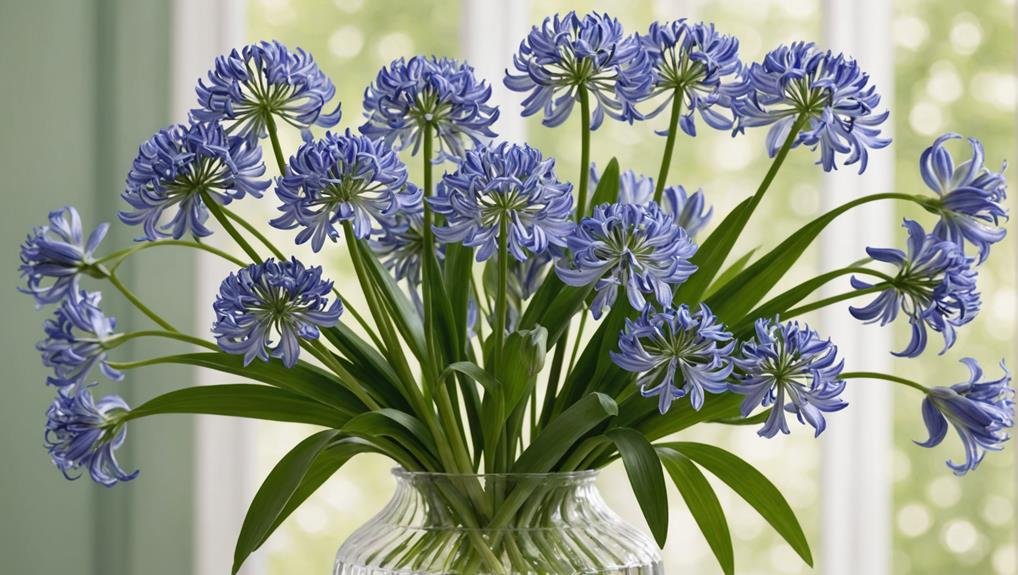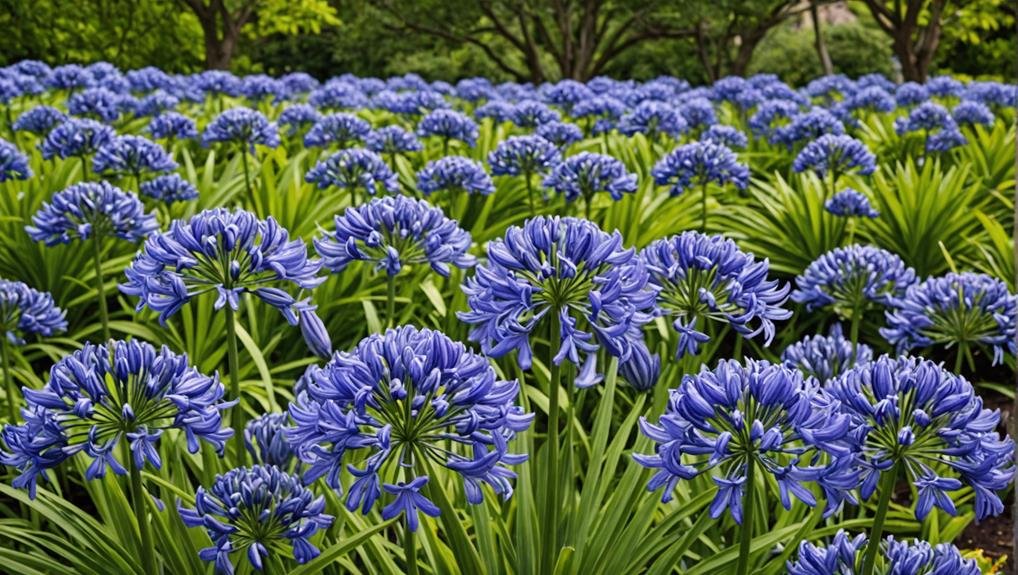When planning a wedding, the selection of flowers can greatly influence the ambiance and aesthetic of the event. Among the many choices available, the Agapanthus flower stands out for its striking beauty and symbolic depth. Known as the Lily of the Nile, this flower offers an array of colors, including blue, purple, and white, each carrying its unique connotations of purity and tranquility. Originating from South Africa, Agapanthus not only adds visual elegance but also a touch of cultural richness to your special day. How does this flower's unique characteristics align with your wedding theme? Stay with us to explore its full potential.
Flower Overview

Agapanthus, commonly known as the Lily of the Nile, is a stunning summer flower native to South Africa. Renowned for its vibrant hues and elegant form, Agapanthus is a popular choice in contemporary wedding floral designs. Its availability in dark blue, light blue, and white varieties allows for versatile application in bridal bouquets and wedding decorations. The white Agapanthus symbolizes purity and innocence, while the blue varieties are often associated with tranquility and elegance, fitting perfectly within the symbolic framework of weddings.
Incorporating Agapanthus into wedding arrangements not only adds aesthetic appeal but also infuses the event with symbolic meaning. As a flower that blooms in summer, it brings a sense of warmth and vibrancy to the occasion. Its long stems and voluminous blooms make it an excellent choice for creating dramatic and eye-catching floral displays. Given its symbolic resonance and visual impact, Agapanthus is frequently chosen for bridal bouquets, adding a touch of sophistication to the bride's ensemble.
For those planning a wedding, the convenience of ordering wholesale Agapanthus online ensures timely delivery and peak freshness, making it easier to achieve a memorable and visually stunning celebration.
Physical Description
The beauty of Agapanthus lies in its trumpet-shaped blooms, which cluster together on tall, robust stems to create a striking visual impact. These flowers, known for their elegance, come in shades of blue, purple, and white. Each Agapanthus stem can support multiple flower heads, making them a popular choice for dramatic bouquets and centerpieces.
The lush foliage of Agapanthus provides a verdant backdrop, allowing the vibrant flowers to truly stand out. The combination of tall, sturdy stems and clustered blooms contributes to the flower's long vase life, ensuring that arrangements remain fresh and beautiful for extended periods. This durability makes Agapanthus an ideal selection for weddings and other special occasions.
To provide a clearer picture of the physical attributes of Agapanthus, consider the following table:
| Attribute | Description | Importance |
|---|---|---|
| Bloom Shape | Trumpet-shaped | Adds elegance and sophistication |
| Color Varieties | Shades of blue, purple, white | Versatile for various themes |
| Stem Structure | Tall and robust | Creates striking visual impact |
| Foliage | Lush and green | Enhances overall appearance |
| Vase Life | Long | Suitable for events |
Agapanthus blooms are not only visually appealing but also practical, offering both beauty and longevity in floral designs.
Available Colour Varieties

Offering a spectrum of hues, Agapanthus flowers come in various color varieties, including blue, purple, and white. These versatile blooms are celebrated for their ability to enhance wedding bouquets and floral arrangements with their distinct shades and meanings.
Blue Agapanthus, often symbolizing trust, sincerity, and royalty, brings a regal touch to any wedding decor. Its calming tones can create a serene and elegant atmosphere, making it a popular choice among couples.
In contrast, purple Agapanthus signifies admiration and elegance. This color variety is perfect for those looking to add a touch of sophistication to their wedding bouquets. It seamlessly blends with other floral elements, enhancing the overall aesthetic of the arrangements.
White Agapanthus, representing purity, innocence, and new beginnings, is particularly fitting for weddings. Its pristine appearance adds a timeless quality to floral designs and is often used to symbolize the fresh start that marriage represents.
The diverse color variations of Agapanthus flowers allow for creative and personalized wedding bouquets. By carefully selecting specific shades, couples can infuse their floral arrangements with deeper layers of symbolism, ensuring that their wedding decor uniquely reflects their personal story and style.
Latin Name and Taxonomy
Belonging to the Agapanthaceae family, Agapanthus africanus is a flowering plant known for its striking clusters of trumpet-shaped blooms. The Latin name Agapanthus africanus is derived from the Greek words 'agape' (meaning love) and 'anthos' (meaning flower), highlighting its poetic connection to affection and beauty. Commonly referred to as the Lily of the Nile, this plant, intriguingly, originates not from the Nile region but from South Africa.
The taxonomy of Agapanthus africanus classifies it within the monocotyledonous flowering plants. It features long, strap-like leaves that provide an elegant backdrop to its vibrant, spherical flower arrangements. These blooms are typically blue or white and bloom during the summer, making them a popular choice for wedding floral designs.
Below is a table summarizing key aspects of Agapanthus africanus:
| Aspect | Description | Notes |
|---|---|---|
| Latin Name | Agapanthus africanus | Derived from Greek words for love and flower |
| Family | Agapanthaceae | Includes other ornamental plants |
| Common Name | Lily of the Nile | Originates from South Africa |
Understanding the Latin name and taxonomy of Agapanthus africanus can help florists and wedding planners appreciate its unique characteristics, ensuring its best use in creating memorable floral arrangements.
Geographical Origins

Known for its striking beauty, Agapanthus africanus originates from the diverse and rich landscapes of South Africa. This remarkable flower, part of the Agapanthaceae family, is often referred to as the 'Lily of the Nile'. However, contrary to its nickname, it is not native to the Nile region. Instead, Agapanthus thrives in the varied climatic zones of South Africa, contributing to its robust adaptability and appeal in contemporary wedding floral designs.
The geographical origins of Agapanthus play a pivotal role in its cultivation and popularity. The plant flourishes in South Africa's unique ecosystem, which supports its growth and seasonal blooming during summer. This background enriches the flower's characteristics, making it a sought-after choice for various decorative purposes.
Key points about Agapanthus' geographical origins include:
- Native to South Africa, not the Nile region
- Part of the Agapanthaceae family, known for resilience and beauty
- Favored in contemporary wedding floral designs due to its striking appearance
- Summer blooming, which aligns with peak wedding season
- Available as Wholesale Agapanthus, typically in wraps of 10 stems
Understanding the geographical origins of Agapanthus enhances appreciation for this versatile and elegant flower.
Season Availability
Cultivated to bloom primarily in the summer, Agapanthus flowers are perfectly aligned with the peak wedding season, making them a highly sought-after choice for floral arrangements. These striking flowers, known for their vibrant blue and white hues, are typically available during the summer season, offering a wide window for their use in weddings and other special events.
To ensure consistent quality and availability, Agapanthus flowers are often cultivated under glass. This controlled environment not only guarantees their seasonal availability but also enhances their aesthetic appeal, making them an ideal choice for summer weddings. The bloom time of Agapanthus harmonizes beautifully with the peak wedding season, providing florists and event planners with ample opportunities to incorporate these flowers into their designs.
The following table highlights the key aspects of Agapanthus flowers' seasonal availability:
| Aspect | Detail |
|---|---|
| Season | Summer |
| Cultivation Method | Under Glass |
| Peak Wedding Season | Summer |
Due to their summer availability, Agapanthus flowers allow for a wide range of floral arrangements and designs, from elegant bouquets to elaborate centerpieces. Their presence can elevate the overall aesthetic of any summer wedding, making them a versatile and dependable choice for couples and florists alike.
Growing Conditions

Understanding the specific growing conditions needed for Agapanthus is essential to maintaining their vibrant and healthy blooms throughout the wedding season. Agapanthus thrives in a variety of soil types, including sand, loam, clay, or chalk, but maintaining well-drained soil is vital. This plant flourishes in a sheltered spot that receives at least six hours of sunlight daily.
Key considerations for ideal Agapanthus growing conditions include:
- Moist Soil: While well-drained soil is crucial, maintaining consistent moisture is equally significant.
- Sunlight: At least six hours of direct sunlight daily ensures strong growth.
- Sheltered Spot: Protection from strong winds helps prevent damage to the blooms.
- Watering Frequency: Watering once or twice a week, especially in well-draining soil, supports healthy growth.
- Fertilization: Using a 1-2-1 ratio fertilizer during Spring and Summer promotes vibrant blooms.
Agapanthus can be planted in pots or flower beds, but it is vital to avoid waterlogged conditions.
In winter, frost protection is necessary, and mulching can help retain moisture and support proper establishment.
Cultural Significance
Rooted in rich history and diverse traditions, Agapanthus holds profound cultural significance that transcends its aesthetic appeal. Originating in South Africa, this flower is not only celebrated for its visual beauty but also for its deep-rooted symbolism and historical connections. In traditional African medicine, Agapanthus was utilized for its purported healing properties, reflecting its integral role in local culture.
Greek mythology also imbues Agapanthus with meaning. The name itself is derived from the Greek words "agape," meaning love, and "anthos," meaning flower, underscoring its association with love and affection. This connection to Greek mythology enriches its cultural significance, making it a symbol of unity and devotion.
| Aspect | Cultural Significance |
|---|---|
| Origin | South Africa |
| Mythological Connection | Greek mythology |
| Symbolism | Love, unity, devotion |
| Victorian Language of Flowers | Love letters, commitment |
| Traditional Use | African medicine |
In the Victorian language of flowers, Agapanthus was often included in love letters, symbolizing deep feelings of love and commitment. This historical context enhances its relevance in modern times, making it a cherished element in floral arrangements and gardens worldwide. The cultural significance of Agapanthus, combined with its aesthetic appeal, renders it a timeless choice for expressing love and devotion.
Typical Use in Weddings

Agapanthus flowers are a popular choice in wedding decor, favored for their elegant appearance and rich symbolism of love and unity. Their incorporation into wedding flowers offers both aesthetic appeal and meaningful symbolism, making them ideal for creating elegant arrangements. The blue and white varieties of Agapanthus add sophistication and charm to romantic wedding floral designs.
The typical use in weddings includes a variety of applications, such as:
- Bridal bouquets
- Centerpieces
- Aisle decorations
- Boutonnieres
- Wedding arches
The symbolism of Agapanthus flowers, representing unity and loyalty, complements the emotional significance of wedding ceremonies. Their long vase life and low maintenance nature further enhance their practicality, ensuring that floral arrangements remain fresh and beautiful throughout the event. Incorporating Agapanthus flowers in weddings brings a touch of elegance and timeless beauty to the celebration.
In addition to their symbolic value, the striking hues of blue and white varieties provide a versatile palette for various wedding themes. Whether used as focal points or accent flowers, Agapanthus contributes to creating memorable and romantic wedding floral designs. Their graceful appearance and enduring nature make them a treasured choice for couples seeking both beauty and meaning in their wedding decor.
Alternative Flower Types
When considering alternative flower types to complement Agapanthus in wedding arrangements, options like roses, lilies, and peonies offer a blend of classic beauty and rich texture. These flowers provide a timeless appeal that enhances the elegance of any bouquet.
To create a unique and diverse floral arrangement, incorporating Campanula, wildflowers, or eucalyptus can add layers of interest and natural charm. The delicate bell-shaped blooms of Campanula and the rustic appeal of wildflowers introduce a whimsical touch, while eucalyptus offers a lush, green backdrop that contrasts beautifully with Agapanthus.
For those seeking a varied and visually appealing bouquet, pairing Agapanthus with Iris Ensata Variegata or Sedum Rose Carpet can be an excellent choice. The striking patterns of Iris Ensata Variegata and the subtle hues of Sedum Rose Carpet add depth and texture, creating a dynamic visual experience.
Additionally, exploring combinations with Geranium Azure Rush or Scilla Peruviana can infuse the bouquet with vibrant color and unique shapes. These selections guarantee a personalized and stunning floral design, with Agapanthus as the focal point, making each arrangement truly memorable for the special day.
